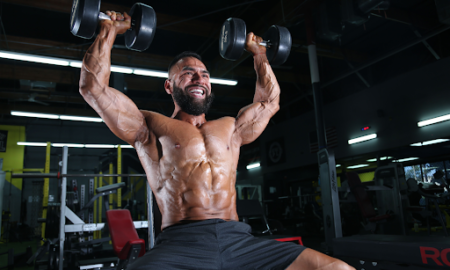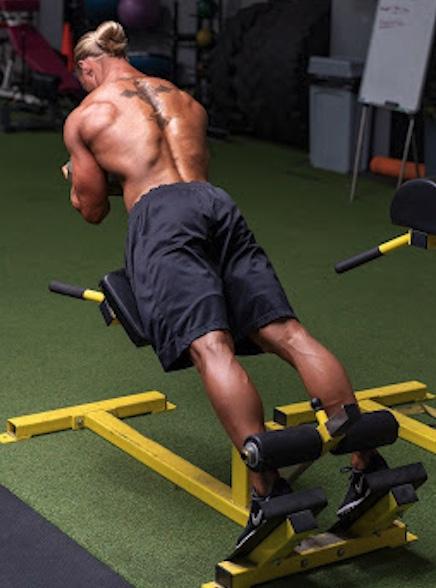

Your lower back muscles play a very crucial role in athletic performance and daily life activities, since they are important for mobility and stability. Having a strong lower is important, whether you are an athlete or not. It is common for athletes and bodybuilders to not pay as much attention to their lower backs as they do to other muscles and body parts.
One reason may be that you don’t see it in the mirror and therefore can neglect it without realizing it. Having a poor lifting form is also something that can damage your lower back. All of these result in one common symptom: Back pain.
To understand the lower back muscles and their working mechanism a little better, we will take a look at its anatomy. The muscle group that many people refer to as the lower back muscles is Erector Spinae (spinal erectors). It forms a part of one of the most important muscle groups in the body i.e. the posterior chain (lower back, glutes, and hamstrings) — the muscles that form a region from behind the knee up until the middle back. When we exercise our lower back, our spinal erectors are involved in it and are exercised in such a way that they contract against a force without altering their length.
The Importance of Working Your Lower Back:
The abdominal region (core), lower back, hamstrings, and glutes bind the upper and lower body together in high-intensity movements like sprinting and jumping for athletes. For people who go to the gym, having a strong lower back will help them gain strength and will also help them with improved balance and performance in squats, curls, deadlifts, etc.
For powerlifters, a strong lower back plays a role in all three of their power lifts. For bodybuilders, a lower back is not only important for strength building but also for the aesthetic look to flaunt. If the lower back muscles are left untrained, athletes can often face lower back injuries during weight lifting. It is important to train your lower back to avoid injuries as well as lower back pain.
What causes lower back injury?
Lower back pain is usually caused by mechanical issues or by soft tissue injuries. These pains can happen suddenly or can develop over time. The most common injuries that result in lower back pain are torn or pulled muscles and ligaments. Following are some of the common causes for lower back pain:
Repetitive motions: Muscles tend to tighten or tear if they are subjected to stressful, repeated motions. These repeated, stressful motions are common in weight lifting exercises as well as sports like golf, baseball, rowing, etc. Such pain may increase over time and worsen if an already sore muscle is exposed to intense stress.
Heavy lifting: During heavy lifting, having your spine or upper body twisted, lifting weight over your head, or lifting a weight off the ground is a common cause of lower back pain. To avoid any lower back injuries while weight lifting, avoid twisting your spine and upper body and hold the weight close to your chest while lifting it.
Poor posture: A slouching posture puts additional stress on the lower back muscles and spine which often leads to lower back pain. Similarly, weak abdominals combined with tight hamstrings also lead to lower back pain.
Skipping warm-up before workout: You must stretch and warm up your muscles before working out. Muscles are inflexible and stiff before you perform an exercise. If they are not warmed up pre-workout and exposed to sudden exertion and stress, they may tear or strain leading to back pain.
Improper exercise forms: The single most common cause of back pain in the gym is the repetitive use of an improper form of exercise. Your lower back is involved in so many workouts, even the ones you may not realize. You must be mindful of slouching or arching your backs during weight lifting. Small things like even sinking your hips during planks or push-ups can cause unneeded stress on your lower back. No matter the workout, try keeping a straight back or maintaining a neutral spine.

Preventing lower back injury:
Following are some ways you can prevent a lower back injury while working out:
Avoid stressful motions: If an exercise is causing you pain, stop performing it immediately. Experiencing pain during an exercise is a negative sign and you should stop right away. Listen to your body and the warning signs.
Know your pain triggers: Some exercises may cause your body immediate discomfort or pain. If an exercise has caused you lower back pain in the past, it may be pain triggering exercise and should be avoided.
Train your muscles: Strength training your lower back muscles can help you prevent back pains. Your lower back carries a great deal of your body weight. If it is weak, weight lifting in the gym, as well as carrying your body weight, will become a painful task. To avoid this you must strength train your lower back.
Exercises for Lower Back:
The lower back muscles are important for mobility, strength, and stability. Stretching and strengthening your lower back can help relieve pain and aches from working out, bad posture, or even constant sitting.
There are dozens of lower back workouts you can choose from. Here are 3 common, effective workouts for your lower back. Incorporating these exercises into your fitness regime can help you build strength, reduce the likelihood of encountering injuries, and ensure a strong lower back:
1. Good mornings
This exercise targets and activates your lower back, hamstrings, and glutes. To perform this exercise:
- Choose an appropriate weight and set up a bar on a squat rack
- The barbell should be placed at such a height that it is slightly lower than your shoulders
- Stand upright with feet hip-width apart, knees slightly bent, and hips right under your shoulders
- Dip under the bar and un-rack the barbell so it is sitting on your upper back and shoulders (similar if you were doing a barbell squat)
- Balance the bar by holding it with your palms on each end
- With the barbell across your shoulders, push your hips backward and allow your upper body to move forward so it is parallel to the floor (bending-over position)
- Engage your core and keep your spine straight
- Hold this position for a moment
- Now return back to the initial upright position. This is one rep.
- Reps: 3 sets, 20 reps.
2. Deficit Deadlifts:
Deficit deadlifts allow an increased range of motions for the performer. To perform this exercise:
- Start off by standing on an elevated platform that is 1-5 inches in height from the ground with feet hip-width apart
- To hold the bar, lower your hips and bend your knees to reach the bar
- Hold the bar with palms shoulder-width apart
- Prepare for your first set by looking straight ahead, back arched, and chest up
- Lift the weight up to your knees while keeping proper form
- Once it reaches your knees, pull the barbell up while contracting your shoulders and driving your hips into it
- Hold this position for a moment
- Return back to the initial position by bending the hips and lowering the barbell. This is one rep.
- Reps: 3 sets, 12 reps
3. Back extensions:
This exercise targets your glutes, shoulders, and hips and also strengthens your back. To perform this exercise:
- Get a hyperextension bench and lie face down on it with arms either in front of you or behind your head
- Lie down such that your thighs are flat across the pad and there is enough space for you to bend your waist
- Now keeping your back flat, slowly start bending forward at the waist
- Continue bending forward till you feel a stretch in your hamstrings (make sure to not round your back)
- Hold this position for a moment
- Now return back to your initial position by lifting up your torso back. This is one rep.
- Reps: 3 sets, 15 reps
Stretches for lower back:
Following are some stretches that can help you relieve your lower back pain as well as improve posture and help you maintain a healthy lower back:
Child’s pose: To perform this:
- Put your hands and knees on the ground and sit back such that your glutes are on your heels
- Now bend your torso forward by hinging at the hips (bowing position)
- Extend your arms fully in front of you
- Relax your body in position and breathe deeply
- Hold this position for 30 seconds to 1 minute.
Knee to chest stretch: To perform this exercise:
- Lie down with your back against the ground
- Bend your knees so your feet are flat on the ground
- Straighten your right leg and let your left knee remain bent
- Lift your left leg from the ground moving your knee towards your chest without lifting your hips, keeping your right leg straight
- Note that the left knee remains bent as you lift it up to your chest by having your palms clasped around the knee
- Hold this position while breathing deeply for 30 seconds 1 minute
- Repeat with right leg
Cobra stretch/ sphinx stretch: To perform this exercise:
- Lie on the ground with face down and back facing the ceiling
- Now extend your hands in front of you with palms flat on the ground and elbows under your shoulder
- With the support of your palms, lift your chest and head ONLY up from the ground and press your pelvis onto the ground
- While going up, engage your core, glutes, and lower back and look straight ahead
- Hold this position while breathing deeply for 30 seconds to 1 minute

Conclusion:
The exercises, stretches, and preventive measures given above will not only help you relieve your back aches but will also help you build strength and have a stronger lower back. Do not perform the above exercises in case of extreme injuries or any other underlying conditions, and consult your general physician or physiotherapist in case of emergencies.























You must be logged in to post a comment Login